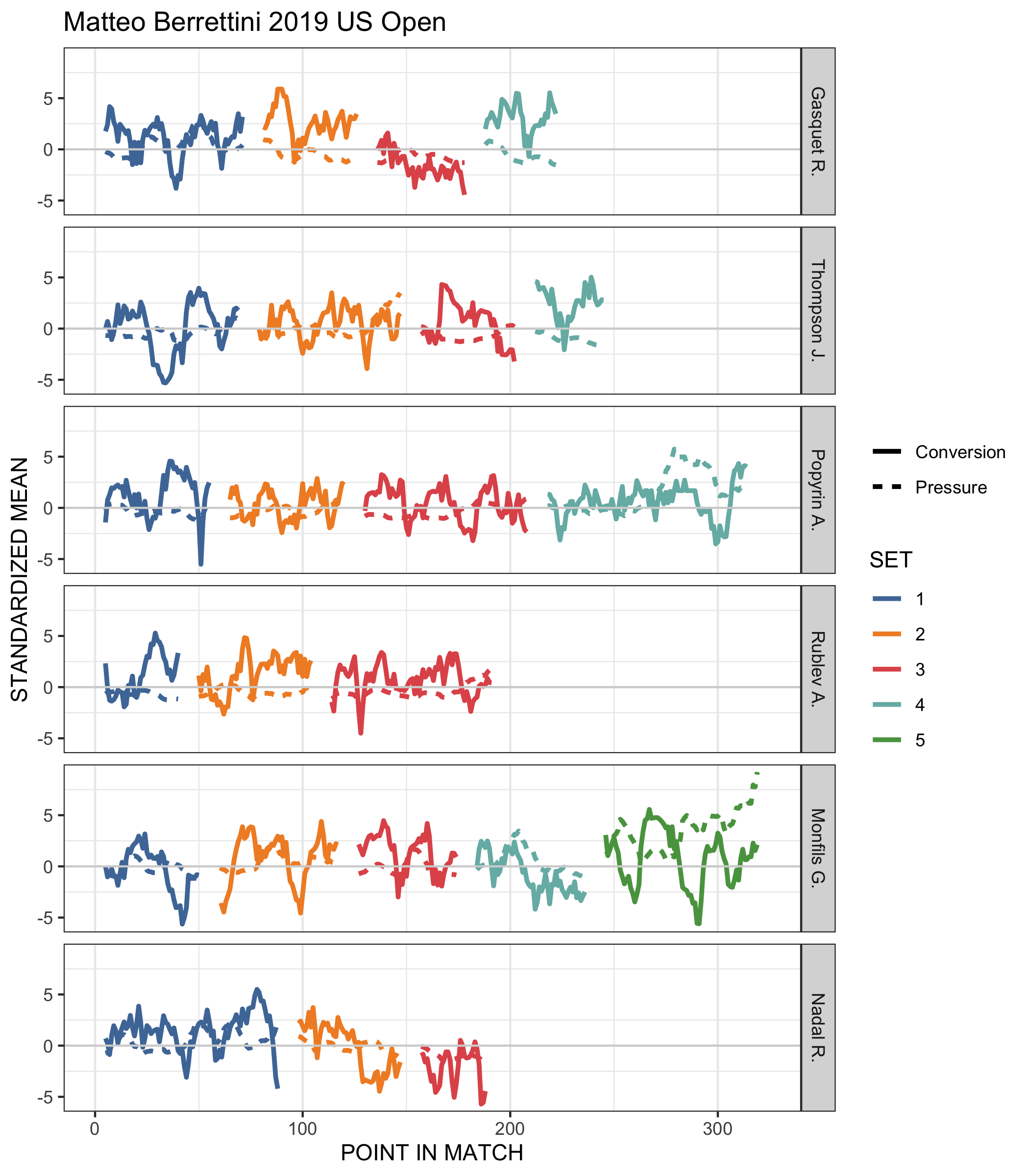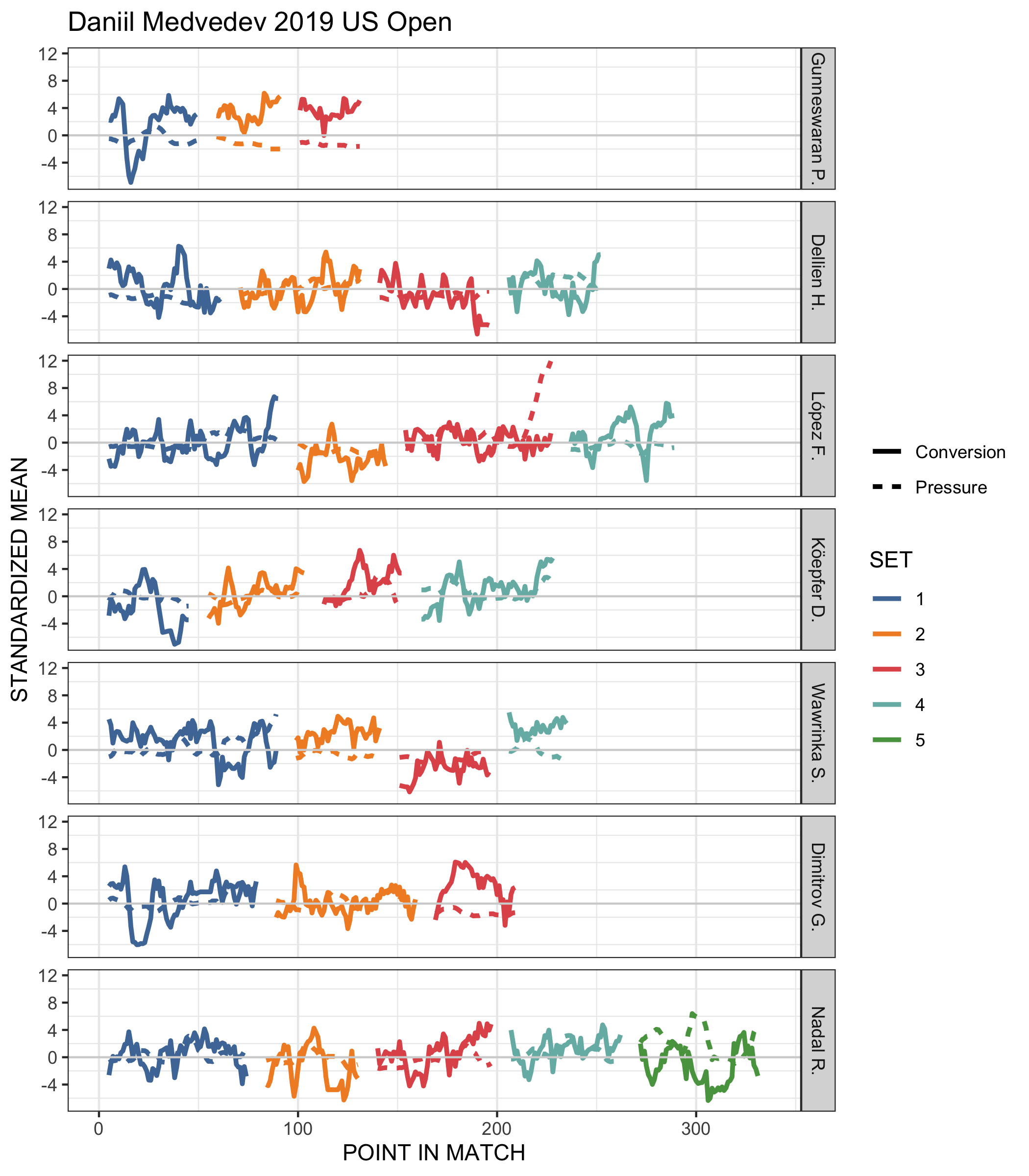How Medvedev and Berrettini Dealt with Pressure at the US Open
The performances of Daniil Medvedev and Matteo Berrettini at the 2019 US Open showed that the future of men’s tennis is bright. In this post, I look at the point-by-point pressure each of these young stars had to confront and analyze how well they responded to it in each round of their US Open journey.
The week after the finals weekend of the US Open is a time of reflection, when we take in what transpired during the last slam of the season and what it might tell us about the direction the sport is going. The incredible runs of Medvedev and Berrettini have been a major thread in those reflections, and have raised expectations that the steamroll of the Big 3 could be challenged by at least some of the Next Gen of men’s players.
With so much interest in what Medvedev and Berrettini just accomplished, I wanted to look more closely at an aspect of their performance that we don’t usually see get the analysis it deserves: that’s point pressure.
Point pressure captures how much a player has to lose on any point. And it can vary tremendously over the course of a match, especially over some of the crucibles that Medvedev and Berrettini experienced at Flushing Meadows.
Starting with semifinalist Berrettini, the chart below shows the trends in the pressure he faced by set (dashed lines) along with his average pressure points converted (solid lines). Over the sets in the tournament, Berrettini faced an average pressure of 2% per set and had an average conversion rate of 51.5%. The pressure and conversion are standardized by those averages and the set-to-set standard deviation so that we can see when he was performing above or below his event averages more easily.
Berrettini most pressure-filled set was the 5th set against Gael Monfils, the only 5-setter he played in the US Open, which ended in a 12-point tiebreak and had an average point pressure of 6.5%. Berrettini’s average conversion in that set was 54.2%, his 2nd strongest pressure performance among the 5 highest pressure sets in the event, his No. 1 pressure performance being the 2nd set win over Monfils where he won 55% of pressure points after going a set down.

It is interesting to see how much Berrettini’s conversion percentage varied in the Monfils quarterfinal. The 5th set in particular flipped and flopped between pressure mastery —like the 6th game where Berrettini broke Monfils at love— and foundering— as when Berrettini had a matchpoint when serving in the 9th game only to be broken in the end. It is clear from his 1set against Nadal, that he was handling the pressure with greater consistency and mental strength than in the last set against Monfils. But when it came to the tiebreak, and those last few points that would decide the set outcome, Berrettini was able to maintain his above average pressure performance against Nadal, whereas he did narrowly edge out the biggest points over Monfils.
How did Medvedev’s pressure results compare?
Like Berrettini, Medvedev faced an average point pressure of 2% in his US Open sets, but had an overall better average conversion rate of 54%. No single set Medvedev played had as high a pressure as the Berrettini-Monfils 5th set, but his 5th set versus Nadal was up there, having an average pressure of 4%. Of the 7 highest-pressure sets Medvedev played at the US Open, the 5th set versus Nadal was the only one where his conversion was below 50%, dropping to 46%.
The set by set conversion patterns in the final shown below suggest a miraculous turnaround for Medvedev that started in the middle of the 3rd. What he did to stay in the match at that point and why that same push slipped so dramatically away by the middle of the 5th, is a puzzle.
We see that the point Medvedev’s conversion rate tanked in the 5th against Nadal was the very moment when the pressure ramped up. But it wasn’t the first time Medvedev was under this kind of game pressure. He had seen it before in the 3rd set tiebreak against Feliciano Lopez, where he was able to maintain his average pressure conversion despite the challenge. Whether it was the occasion, fatigue, or just a bad streak in those final points against Nadal may be something we never know. If Medvedev has the drive to be a slam champion that he appears to, we can expect he will be wrestling with these questions and searching for a solution ahead of the 2020 season.


